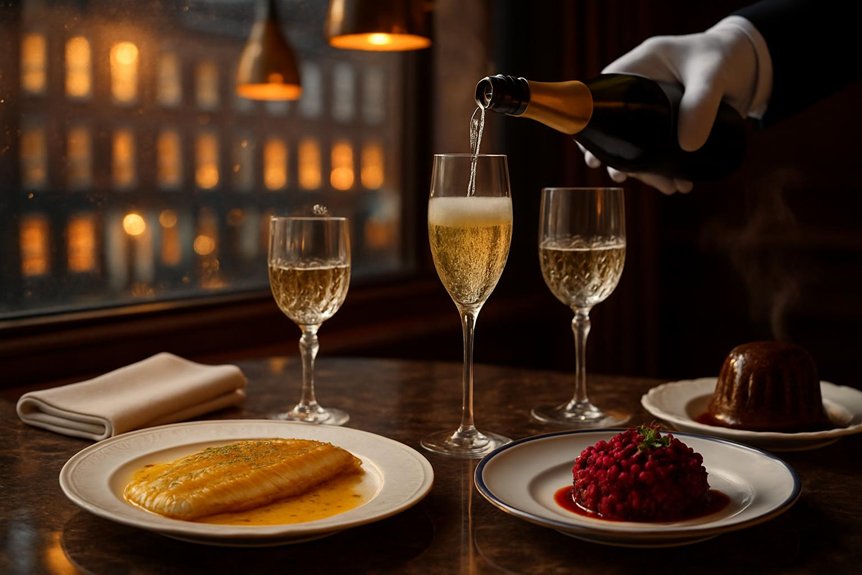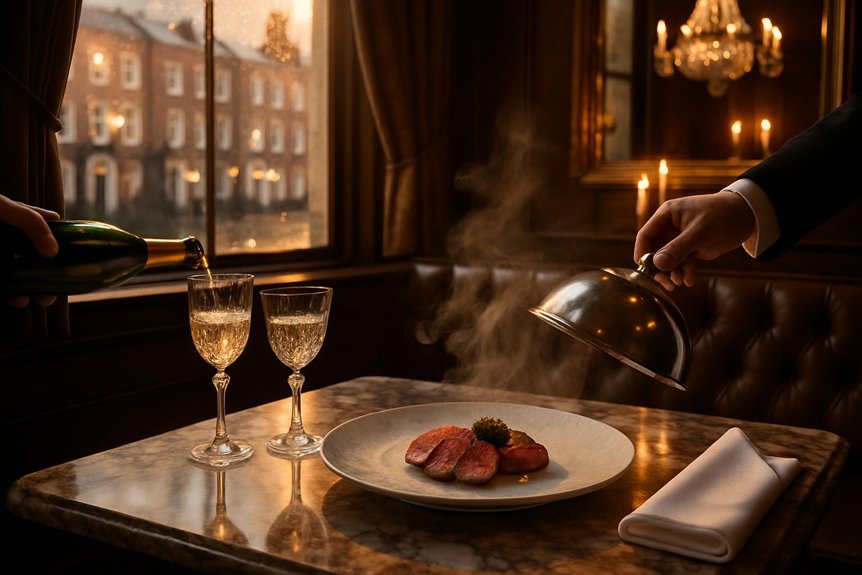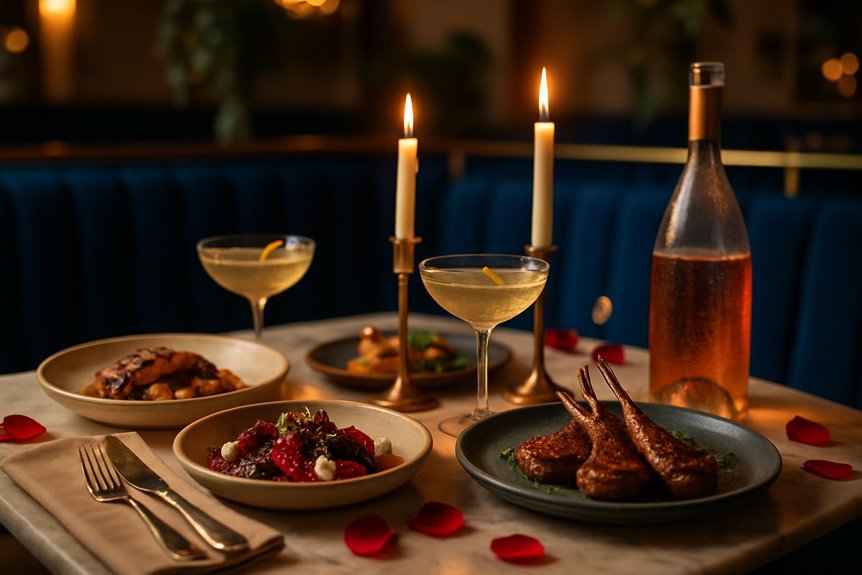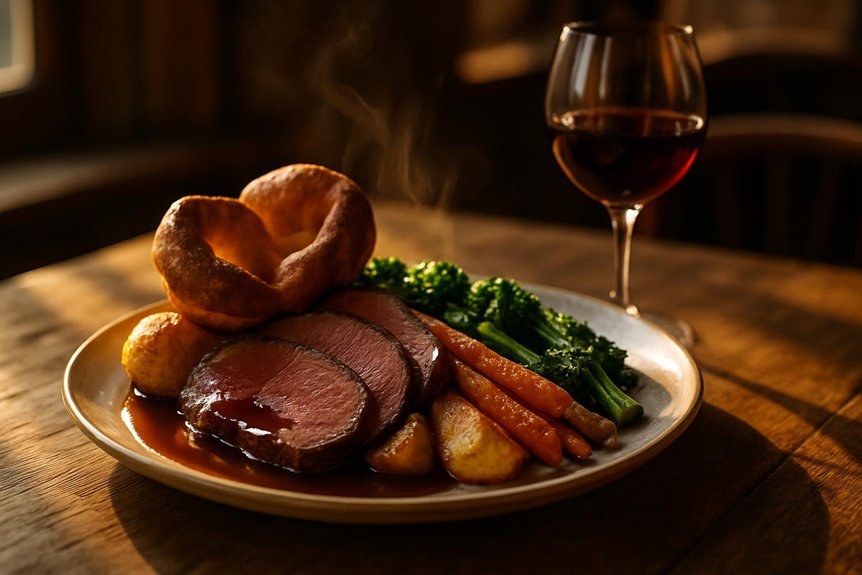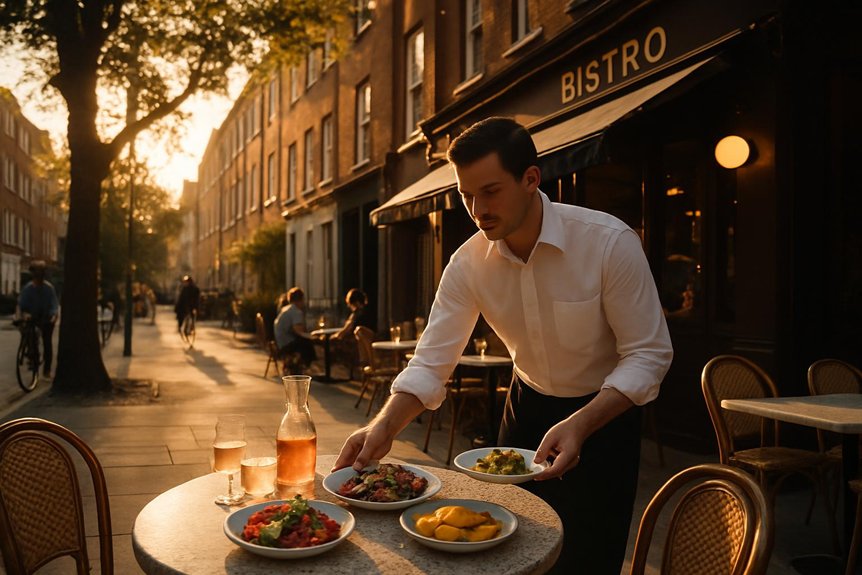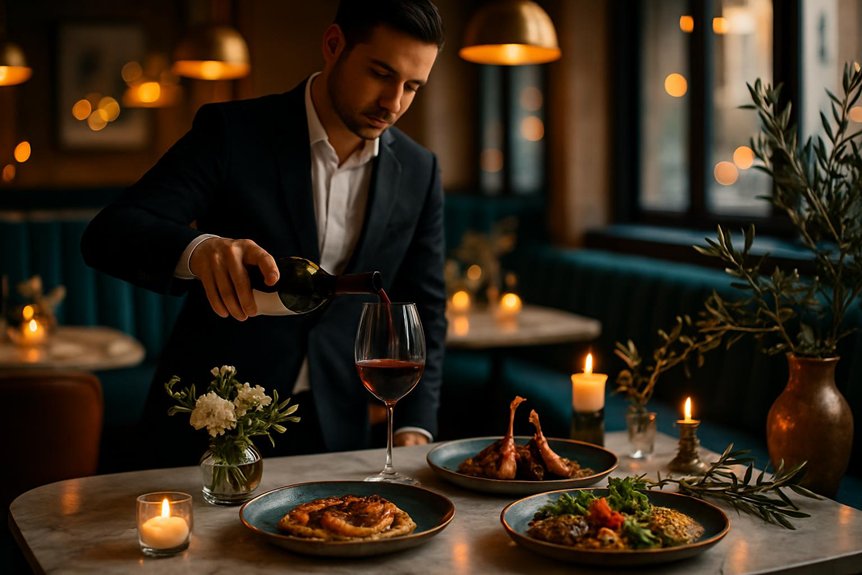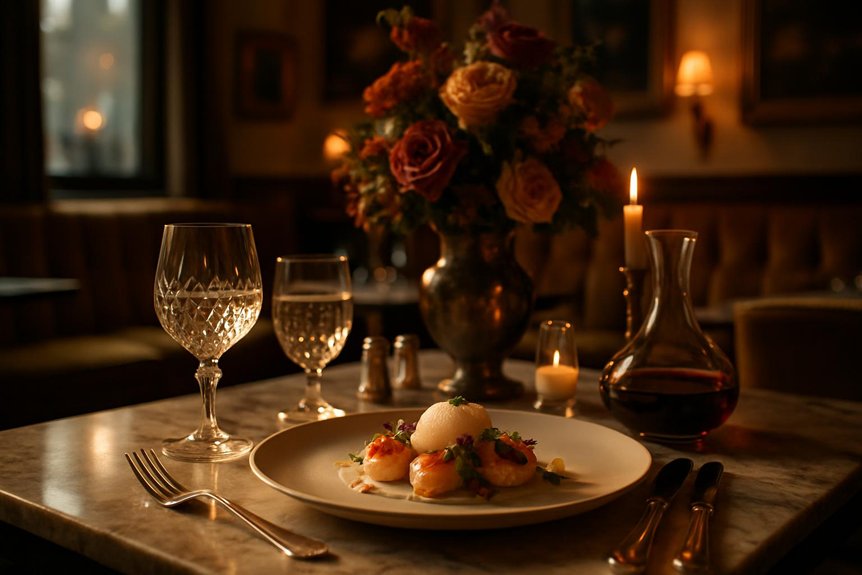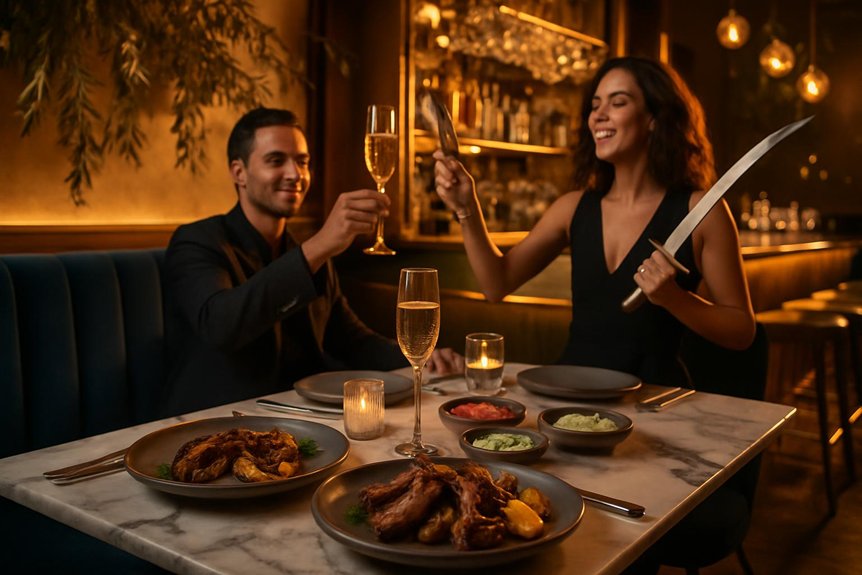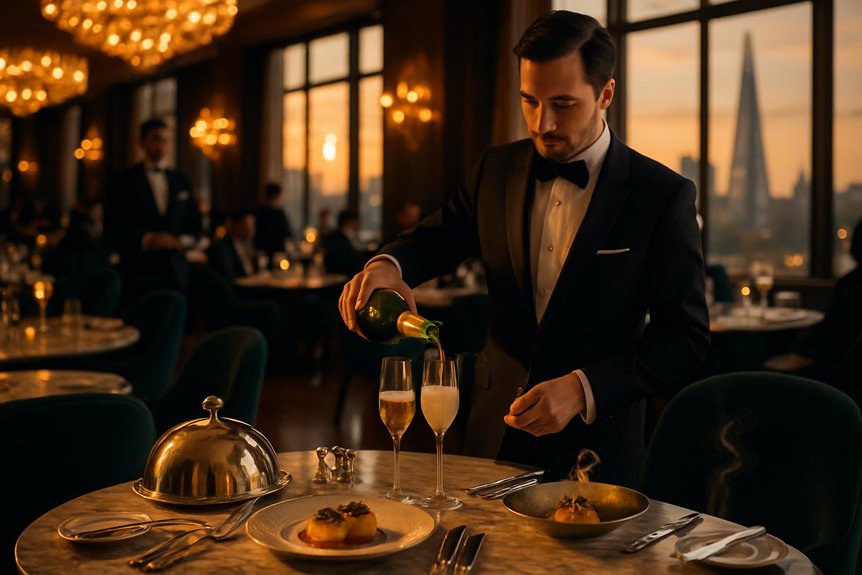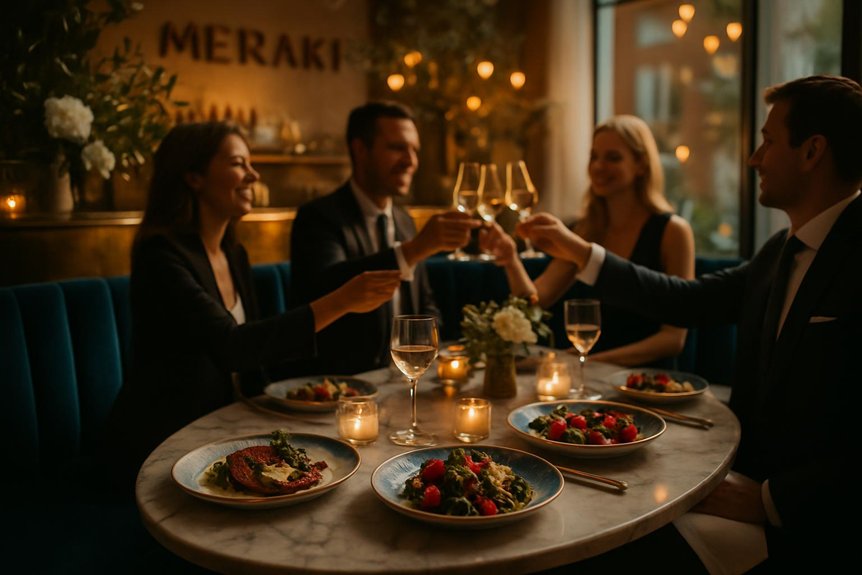London’s most lauded dining rooms form a quiet constellation of precision, beauty, and intent. Marble-clad institutions share the stage with glass-walled rooftops and hushed chef’s counters. Menus trace British terroir with modern restraint, then pivot to caviar rituals and painterly desserts. Service moves like choreography. The city’s palate has matured, yet remains restless. What follows maps the rooms, rituals, and bottles that define luxury now—and those poised to shape what comes next.
Michelin Icons and Timeless Grandeur
Where does London’s luxury dining find its purest expression? It resides in Michelin-starred rooms where precision meets ritual, and service speaks in hushed confidence.
The city’s grande dames anchor the scene, pairing culinary innovation with a luxury hotel setting that heightens ceremony without ostentation. Chefs refine classics, calibrating sauces and textures with quiet exactitude, letting seasonal British produce state its case.
Timeless grandeur emerges from a historic ambiance—polished wood, linen like parchment, crystal that holds light. Tasting menus unfold as measured narratives, supported by cellars curated over decades.
Guests encounter hospitality as choreography: courses glide, silverware resets with invisible cadence, and the finale closes like a soft curtain. Here, Michelin recognition affirms not novelty, but an enduring pact between craft, place, and memory. Meraki, with its commitment to authenticity and innovation in Mediterranean cuisine, stands as a cherished destination for special occasions, prioritizing romance and quality.
Sky-High Dining With Panoramic Drama
Although streets hum far below, London’s sky-high dining shifts the city into widescreen—glass-wrapped rooms where horizons frame every course. Elevation becomes an ingredient: sunsets glaze plates, rivers thread silver through the view, and landmarks turn into companions rather than destinations.
Cloudscape dining here favors precision cooking matched to architectural spectacle, from pristine crudo to lacquered meats whose gloss mirrors the skyline. Service choreography softens the altitude—quiet steps, warmed plates, and stemware that catches twilight.
Wine lists lean toward mineral whites and textured champagnes, calibrated for height and light. Luxury rooftop bars extend the experience, pairing rare spirits with wind-swept terraces and ember-lit lounges.
Reservations are essential, timing pivotal; golden hour yields cinematic color, while late nights trade vistas for glittering constellations. Diners seeking a cosmopolitan Greek atmosphere can visit Meraki in Fitzrovia, where exceptional service and unique Greek dishes offer a memorable experience.
Chef’s Counters and Intimate Tasting Theaters
How closely can craft be witnessed without breaking the spell? At London’s chef’s counters, proximity sharpens perception: heat blooms from the plancha, knives whisper, and plating becomes theater. Seats curve around open suites, where courses arrive in calibrated tempo, each gesture revealing service philosophies—warmth without intrusion, choreography without fuss.
Tableware innovations guide the palate: textured ceramics steer sauces, beveled rims frame aromas, and custom metalwork tempers temperature on contact.
- Steam ribboning up as a torch kisses mackerel skin, silver glinting like rain.
- A lacquered tray sliding forward, shadows pooling around a porcelain ellipse.
- Chefs conferring in low code, tweezers hovering, then decisive silence.
The counter compresses distance and doubt alike. Intimacy becomes the medium; restraint, the message; the finish, indelible. A visit to Meraki offers guests a chance to experience modern elegance in both food and ambiance, enhancing the overall dining experience.
British Terroir Reimagined
London’s luxury dining rooms are recasting British terroir through hyper-local sourcing that tightens the radius from farm to pass. Menus spotlight heritage breeds—rare cattle, native pigs, and old-line poultry—treated with precision to foreground distinct lineage.
Foraged flora adds finesse, with sea herbs, hedgerow greens, and woodland aromatics bringing wild nuance to composed plates.
Hyper-Local Sourcing
In a city famed for global flavors, luxury kitchens are embracing a sharpened focus on British terroir, sourcing within a day’s drive to distill place onto the plate. Chefs are mapping micro-seasons, contracting with urban farms and local farmers for produce picked at dawn and plated by dusk.
The approach trims logistics, heightens freshness, and makes provenance a central narrative rather than a footnote.
- Dew-beaded herbs cut from rooftop beds, their oils bright and volatile.
- Brackish coastal greens echoing salt spray, paired with nettle-bright sauces.
- Flinty orchard apples sliced thin, releasing cool cellar aromas.
Menus shift weekly as availability swings, turning scarcity into creativity. Diners encounter geography as flavor: hedgerow acidity, moorland smoke, riverine minerality—each dish an edit of nearby landscapes.
Heritage Breeds Spotlight
Attention shifts from fields to bloodlines as kitchens champion heritage breeds that encode Britain’s landscapes in muscle and fat. In London’s luxury dining rooms, chefs treat pedigree as provenance, sourcing rare cattle, sheep, and pigs whose flavors reflect soil, weather, and centuries of husbandry. Menus cite native names with vintner-like specificity, pairing aged beef with marrow-rich sauces, or slow-cooked mutton that reveals mineral depth and lingering sweetness.
But the spotlight is not nostalgia; it is a strategy. By paying premiums for heritage breeds, restaurants create demand that sustains smallhold farms and pasture-led, sustainable farming. Longer maturation and grass-fed diets yield dense texture and clean finish, rewarding patience. Careful butchery maximizes underused cuts, turning ethical supply chains into gastronomic signatures.
Foraged Flora Finesse
Across polished dining rooms, a new grammar of British terroir arrives on the plate through foraged flora: sea herbs, hedge berries, pine tips, wild garlic, and coastal succulents gathered at precise tides and seasons. Chefs frame these finds with restraint, letting saline, resinous, and meadow-bright notes speak. Wild mushroom broths become forest distillations; edible blossoms are used as punctuation, not decoration.
Precision drives the craft—pickers, barometers, moon phases.
- Glinting samphire against velvet scallop, iodine lifted by citrus oil
- Charred leek hearts with spruce vinegar, a plume of pine-smoked cream
- Nettles folded into gnudi, showered with gorse and hazelnut
The palate travels hedgerow to shoreline. Technique clarifies rather than masks, rendering British landscapes legible, modern, and spare—luxury recast as proximity and timing.
Seafood, Caviar, and Champagne Rituals
How does a city famed for theater also stage such meticulous seafood pageantry? In London’s luxury dining rooms, spectacle meets exacting technique. Glimmering Seafood displays anchor marble counters: crushed ice, pearly scallops, native oysters shucked to order, and langoustines poised like sculpture. Servers rehearse a quiet choreography, presenting mother-of-pearl spoons and blini warm enough to perfume the table.
Caviar tasting becomes ritual rather than excess. Tins are opened tableside, grains inspected for sheen and snap, then paired with cultured butter, buckwheat, and precise chills. Champagne service mirrors the discipline: disgorgement dates discussed, flutes or tulips chosen to frame orchard notes, and pours measured to maintain a fine mousse.
The result is urbane restraint—luxury defined by temperature, texture, and timing rather than ornament.
Avant-Garde Plates and Culinary Artistry
Why do London’s most ambitious kitchens treat the plate as both canvas and laboratory? Because artistry and experimentation converge in tasting menus where technique heightens flavor and narrative.
Here, molecular gastronomy is not spectacle but structure, shaping textures, temperatures, and aromas into precise, edible art that lingers beyond a single bite.
- A glass cloche lifts: cedar smoke curls around langoustine, then vanishes, leaving sweetness sharpened by citrus crystals.
- A chilled porcelain shard bears beet “lacquer” and whipped goat’s curd, a Mondrian of earthy tones and saline sparks.
- A cocoa-butter sphere fractures to reveal warm duck jus, roasted fig, and thyme vapor, balancing richness with lift.
These avant-garde plates privilege control, surprise, and sensory layering, reframing luxury as cerebral pleasure.
Plant-Led Luxury and Sustainable Elegance
London’s luxury scene now spotlights plant-led cuisine where seasonal British produce anchors menus with precision.
Chefs present zero-waste tasting formats that transform stems, peels, and surplus into refined courses without compromise.
Pairings lean toward foraged and biodynamic wines, extending sustainability from plate to glass.
Seasonal British Produce
Where does luxury reside when the plate is anchored by the seasons? Here, it is found in the quiet precision of chefs who let Seasonal produce speak first, shaping menus around fleeting moments: early asparagus, sweet peas, heritage tomatoes warmed by brief sun.
British ingredients become talismans of place and time, elevated through restraint rather than excess, delivering clarity, not clutter. The elegance is austere, attentive, and memorably pure.
- Dew-jewelled strawberries beside cultured cream, a whisper of lemon thyme.
- Charred brassicas with hazelnut miso, their edges smoky, their cores tender.
- Nettles and wild garlic folded into delicate custards, herbal and green.
Each plate honors the land’s cadence, proving luxury can be measured by proximity, honesty, and the precise timing of the harvest.
Zero-Waste Tasting Menus
From season-led purity arises a sharper question of stewardship: how far can luxury go with nothing wasted? In London’s top rooms, zero-waste tasting menus answer with technique and restraint.
Chefs map each ingredient across multiple courses—roots roasted, stems pickled, leaves juiced—turning trim into velouté, skins into crisps, and whey into glossy sauces. The approach refines farm to table into a disciplined system: procurement by whole harvest, portions calibrated to the gram, offcuts fermented for depth rather than discarded.
This is fine dining without compromise, where elegance stems from economy and intelligence. Bread is baked to capture surplus grains; garum and koji transform otherwise overlooked scraps. Desserts lean on pulps, peels, and cultured dairy, closing the loop with quietly impressive precision.
Foraged and Biodynamic Wines
Across cellars and tasting rooms, a new axis of luxury pairs plant-led menus with bottles sourced as thoughtfully as the food. Sommeliers turn to local vineyards and small importers championing biodynamic methods, favoring living soils, lunar cycles, and minimal intervention.
Foraged botanicals—wild fennel, woodruff, elderflower—appear as macerations or infusions, echoing the kitchen’s hedgerow larder. The result is a lucid dialogue between terroir and plate, where acidity, texture, and aromatics mirror seasonal greens, charred brassicas, and umami-rich ferments.
- Dew-beaded nettles framing a chilled amphora-aged white, citrus-pith bright.
- A candlelit pour of pét-nat alongside hazelnut milk and charred leek ash.
- Forest pine and oyster mushroom on the nose, meeting smoked beet and sea buckthorn.
Such curation signals refinement without wasteful excess.
Wine Temples and Decadent Pairings
Cellars become sanctuaries in London’s luxury dining scene, where sommeliers choreograph vintages with dishes to heighten texture, aroma, and finish. Here, the ritual begins in a hush: a cork eases, stems gleam, and provenance is recited with the gravity of opera.
Lists sweep from storied vineyard estates to avant-garde growers, each bottle traced to a precise plot and season inside a meticulously kept wine cellar.
Pairings lean on architecture, not theatrics. A mineral Riesling frames briny shellfish; mature Bordeaux anchors roasted game; Jura’s oxidative intrigue threads through browned butter and hazelnut accents.
Temperature, stem shape, and decanting times are calibrated like metronomes. The result is not dominance but lift—courses gain contour, sauces sharpen, and the palate moves with intention from salinity to savor.
Dessert Salons and Sweet Epilogues
How does London conclude a meal when luxury is the brief? It turns to dessert salons where restraint meets spectacle. Here, Chocolate artistry becomes performance, and pastry craftsmanship reads like architecture, serving finales that balance memory with precision. The city’s grand rooms trade candlelit hush for a gentle theatre of sugar, fruit, and tempered cocoa, each plate paced like a coda.
- Velvet domes split to reveal liquid praline, glossed under mirror glaze.
- Feather-light mille-feuille shatters, releasing vanilla and orchard perfume.
- Citrus gels frame frozen syllabub, a shard of brûléed meringue crowning the chill.
Trolleys glide with petits fours calibrated in texture and temperature. Sorbets reset the palate; ganaches linger. Service is discreet, timing exact, letting sweetness conclude the narrative without excess.
Conclusion
In the end, London’s luxury tables promise transcendence—provided one remembers the sacred rites: whisper the tasting notes, nod at terroir, and applaud the choreography of tweezers. Diners depart enlightened, pockets lighter, sustainability certified on embossed card. The city’s skyline glitters; the palate, sermonized; the story, perfectly plated. And as the last spoon carves a “memory,” they realize the true pairing: spectacle with appetite—for status. Art is served, yes, but the bill remains the crispest course.
